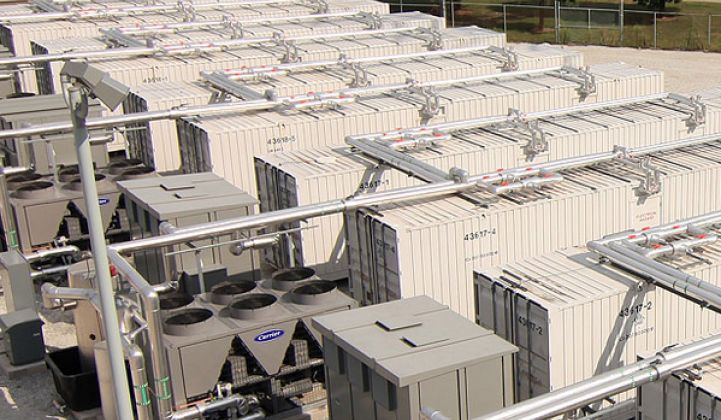There’s a difference between knowing why energy storage is so useful to integrating wind and solar power into the grid, and being able to prove it to a banker. They’re going to want to know all the details in between, such as: Has anyone ever been paid for performing these tasks? If so, how much? And can we get that price in a 10-year contract?
To be sure, we’ve seen hundreds of megawatts of energy storage bankrolled through utility contracts, as in California, or to serve once-lucrative frequency regulation services, as in the territory of mid-Atlantic grid operator PJM.
But the structures aren’t quite there yet for energy storage to provide the bankable revenue streams that wind and solar project financial backers need to make deals -- even if the desire for them is peaking.
“The reality is that storage hasn’t been widely financed yet, and we’re still several years away,” Ravina Advani, managing director of BNP Paribas’ power and infrastructure project finance group, said during a webinar on merchant power trends held Wednesday by the American Council on Renewable Energy (ACORE) and Bloomberg New Energy Finance. “Financing with a renewal asset,” on the other hand, “I think is something the market hasn’t yet seen -- but it’s an up-and-coming trend.”
Wednesday’s storage discussion came during a broader overview of merchant power industry trends, from the latest BNEF data on global clean energy investments, to forecasts on solar industry impacts from the Suniva trade case.
But for renewables, the key long-term market trends are the shift from state renewable portfolio standards, power-purchase agreements and renewable energy credits as key drivers, to a world in which corporate investors, community choice aggregators and the Public Utility Regulatory Policies Act (PURPA) are playing a larger role, said Steve Doyon, CEO of Novatus Energy. Energy storage "could help renewables transition to that type of market."
The role of energy storage will be part of the discussion at Greentech Media’s U.S. Power & Renewables 2017 conference this November. In Wednesday’s webinar, executives in renewable energy development, origination and financing said the opportunities for storage to help bridge this gap are tantalizingly close. “We still haven’t seen all the things we think storage might do,” Doyon said. “That market is really struggling to come up with a revenue model.”
To be sure, there are a handful of multi-megawatt renewable-storage systems up and running today, such as the AES 32-megawatt battery storage project co-located with the 98-megawatt Laurel Mountain Wind Farm. The project, built in 2011, was financed to take advantage of federal tax incentives. It was also a showcase project to help launch its AES Energy Storage business, now the world’s biggest battery grid storage developer and a partner with Siemens.
In July, AES took $2 billion in non-recourse financing for a project that combined 100 megawatts of four-hour duration battery storage with the repowering of a 1.3-gigawatt combined cycle gas plant in Southern California, under a 20-year PPA with Southern California Edison -- as part of the utility's broader energy storage procurement for local capacity.
For standalone battery projects, the chief challenge remains finding a steady and predictable revenue stream, she said. “It’s really tough to finance a revenue stream that’s coming from providing frequency regulation to the grid” -- a fact borne out in PJM’s market. “It’s tough unless you have some form of predictable payment.”
That, in turn, will require some “upmarket changes that really facilitate storage and allow a consistent revenue model to drive costs down,” Doyon said. One idea under discussion was using storage to firm up an intermittent generator’s output for commitment as a capacity resource. That would allowing wind and solar projects to expand their participation in capacity markets run by the country’s regional transmission organizations and independent system operators, alongside generators and demand response.
Utilities outside these structured capacity markets are also exploring energy storage to manage grid imbalances that come with increasing penetration of wind and solar. In California, Hawaii and other markets with “duck curves,” large-scale PV is surging at midday and falling away in the evening, causing steep bellies and ramps in grid supply-demand curves that require new fast-acting resources to manage, said Dai Owen, director of power marketing at EDF Renewable Energy. In these markets, ”a lot of people are talking about storage starting to make sense in a few years.”
Greentech Media’s U.S. Power & Renewables 2017 conference in Austin, Texas will bring top regulatory, utility and technology leaders together with the solar expertise of GTM Research, the wind energy analysis of MAKE, and the broader energy and utilities expertise of Wood Mackenzie, for an end-to-end view across the entire energy market value chain. Energy storage will be included. Learn more here.



